Carpal tunnel release surgery can treat the symptoms of carpal tunnel syndrome (CTS) if splinting, medications, or other treatments do not provide relief.
Carpal tunnel syndrome occurs when a trapped nerve in the wrist causes pain, numbness, and tingling.
Doctors may initially recommend changing daily activity, splinting the wrist overnight, or injecting steroids into the wrist. However, people with severe or persistent CTS may benefit from carpal tunnel release.
Read on to learn more about surgery for CTS. This article looks at what carpal tunnel release involves, when doctors recommend it, the benefits and possible risks of the procedure, and more.

The surgery for CTS is called carpal tunnel release. It
The surgeon administers either a local or sometimes an intravenous (IV) sedative to numb the area or general anesthesia to put an individual to sleep during the procedure.
The procedure is either open or endoscopic. Open carpal tunnel release means the surgeon makes a cut in the palm and views the surgery through this opening. Endoscopic carpal tunnel release means the surgeon inserts a small, flexible, lighted camera through a smaller cut and views the procedure using this device.
In either procedure, the surgeon divides the transverse carpal ligament. This may grow back over time, but it often leaves more room for the median nerve when it does.
Doctors recommend carpal tunnel release for people with
A doctor may confirm the severity of CTS through
According to a
- relieving pain
- restoring strength and dexterity
- resolving symptoms
- reducing the time needed to return to normal daily activities
- restoring function
- reducing the time necessary for people with CTS to return to work
- minimizing the risk of adverse events
Several studies in the review suggested that people who received the endoscopic technique returned to work and daily activities quicker than those who received open carpal tunnel release.
Carpal tunnel release can also help prevent permanent damage in people with long-term CTS who experience constant numbness and muscle wasting in the thumbs.
Depending on the type of anesthesia a person receives, the doctor may request that a person not eat or drink anything after midnight leading up to the procedure.
People who take regular medications should seek advice from their surgeon on whether they can continue to take the medication on the day.
It is also important to arrange travel plans for getting home after the procedure, as anesthesia can cause grogginess, and a person should not drive.
People often do not need to stay in the hospital for a carpal tunnel release and can go home on the day of the surgery. However, it is important to check this with a doctor beforehand.
Straight after surgery, a doctor will encourage the individual to keep their hand lifted above the heart and move their fingers. This can help reduce swelling and stiffness, though both are likely to occur along with pain after the procedure. People might have sore palms for weeks to months after the procedure.
Usually, the recovery timeline is as follows:
- One week after surgery: Nighttime symptoms feel much better. Numbness and tingling resolve for some people right after surgery.
- Several weeks after surgery: A person may still have to wear a splint or wrist brace. They can use their hand for light activities, including driving, light lifting, and self-care.
- Months after surgery: Numbness, tingling, and weakness in gripping and pinching movements can all take months to fully recover. This can take 6–12 months for people whose median nerve was in very poor condition.
Learn about the risks of overdoing it after CTS surgery.
As with any procedure, there are possible risks of CTS surgery. These can include:
- bleeding
- infections
- slow wound healing
- aggravation or injury to the nerve
However, complications are very rare, according to the American Society for Surgery of the Hand.
Here are some frequently asked questions about surgery for carpal tunnel syndrome.
What are the restrictions after carpal tunnel surgery?
People should avoid driving themselves home immediately after the procedure. They can engage in light activities, such as texting, eating, reading, or watching TV. It is best not to lift anything heavier than a cell phone for about 1 week after surgery. People should also aim to keep the hand lifted above the heart as often as possible and avoid hard manual labor.
How long does it take to recover from carpal tunnel surgery?
Recovery from carpal tunnel surgery is gradual over a period of weeks and months. People might feel pain and stiffness immediately after the procedure. Soreness in their palms may persist for months.
However, people who usually do light desk work may be able to return to work around 2–3 days after the procedure. Those who have physically intensive jobs may need to wait 4–6 weeks to return to work.
Can I use my hand after carpal tunnel surgery?
After surgery, people can use their hands for light activities, such as lifting a cell phone. Movement is safe, but lifting heavy objects is not.
How soon can you exercise your hand after carpal tunnel surgery?
People can start to exercise their hand around 6 weeks after surgery. This can help to support recovery.
Can I drive myself home after carpal tunnel surgery?
People should plan to get a ride home after carpal tunnel surgery, as the anesthesia may cause grogginess and make driving unsafe.
Carpal tunnel release is a type of surgery for carpal tunnel syndrome (CTS). It involves cutting the transverse ligament at the roof of the wrist’s carpal tunnel.
It may be a suitable treatment for severe CTS or in cases where conservative treatments do not relieve symptoms. It is a same-day procedure that a surgeon performs under local or general anesthesia.
After surgery, people should avoid driving themselves home. Full recovery can take several months, but a return to light work and activity can happen much sooner.
